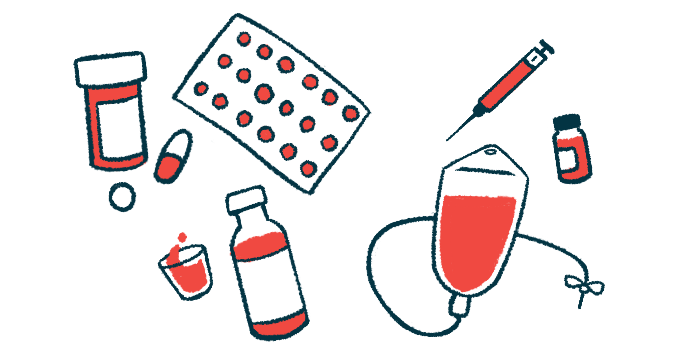Vyvgart Hytrulo as effective as Vyvgart at reducing IgG levels
Subcutaneous injection expected to be more convenient to administer
Written by |

Vyvgart Hytrulo (efgartigimod alfa and hyaluronidase), an approved therapy for generalized myasthenia gravis (gMG) that’s injected under the skin, or subcutaneously, appears to be as effective as the intravenous treatment Vyvgart (efgartigimod alfa) at reducing IgG antibodies, including those that cause the disease.
That’s according to data from ADAPT-SC (NCT04735432), a noninferiority Phase 3 clinical trial that tested whether Vyvgart Hytrulo isn’t worse than Vyvgart, and its open-label extension ADAPT-SC+ (NCT04818671), which is evaluating Vyvgart Hytrulo’s long-term safety and efficacy in adults with gMG.
While both treatments were well tolerated and provided similar benefits, Vyvgart Hytrulo should be more convenient to administer by patients and caregivers after adequate training, usually in less than two minutes. An intravenous infusion takes about an hour and must be administered by a trained healthcare professional.
The findings were detailed in the study, “Subcutaneous efgartigimod PH20 in generalized myasthenia gravis: A phase 3 randomized noninferiority study (ADAPT-SC) and interim analyses of a long-term open-label extension study (ADAPT-SC+),” which was published in Neurotherapeutics. The research was funded by Argenx, which markets both treatments.
Like Vyvgart, Vyvgart Hytrulo is approved for adults with gMG who test positive for a type of self-reactive IgG antibody that targets the acetylcholine receptor (AChR) and interferes with nerve-to-muscle communication, leading to symptoms of muscle weakness and fatigue.
The treatments block the action of the neonatal Fc receptor (FcRn) protein, which normally helps stabilize IgG antibodies circulating in the blood. Blocking FcRn hastens the rate at which IgG antibodies are broken down, including the self-reactive ones that cause MG, lowering their levels and easing MG symptoms.
Comparing subcutaneous Vyvgart Hytrulo, intravenous Vyvgart
ADAPT-SC included 110 adults with gMG who were randomly assigned to either four weekly doses of 1,000 mg of Vyvgart Hytrulo or Vyvgart at 10 mg/kg over four weeks.
As reported, Vyvgart Hytrulo was as effective as Vyvgart at reducing total IgG antibodies a week after the last dose (mean drop, 66.4% vs. 62.2%).
Consistent with data from ADAPT (NCT03669588), which tested Vyvgart against a placebo, about two-thirds (69.1%) of the patients treated with Vyvgart Hytrulo had clinically meaningful improvements in MG Activities of Daily Living (MG-ADL) scores and 65.5% in Quantitative MG (QMG) scores. MG-ADL is a patient-reported measure of disease severity, while QMG is a measure of severity as reported by doctors.
After the initial ADAPT-SC study, 105 patients entered the ongoing ADAPT-SC+ extension, along with 73 from ADAPT+ (NCT03770403), an open-label extension of ADAPT. ADAPT-SC+ enabled patients to either continue or be started on Vyvgart Hytrulo as administered in four weekly cycles for up to three years to gather more data about how well they tolerated it and responded to it over a longer period.
Of 178 patients, 164 received at least one dose of Vyvgart Hytrulo. Fourteen didn’t need treatment or weren’t treated. At the data cutoff, 160 (97.6%) of the remaining 164 patients were still in the study. Of these, 142 had started the second treatment cycle, and 105 had started the third. The mean follow-up time was 169.7 days, or about 5.5 months.
As presented in a scientific meeting last year, Vyvgart Hytrulo consistently lowered the impact of MG on daily functions, as indicated by a mean drop of about 4 points in MG-ADL scores by the first three treatment cycles. Similar results were seen in patients with anti-AChR antibodies, who made up 81.7% of the study population.
Around a third of patients had an MG-ADL score of 0 or 1, suggesting minimal symptoms, at any time point within a treatment cycle, ranging from 30.2% in the first to 35.9% in the third. The greatest improvements aligned with the maximum reduction in circulating IgG antibody levels, which occurred after four weeks.
Most patients (88%) were considered to be adequately trained to self-administer their treatments, and by cycle 3, nearly 60% could do so in their homes. Also, 71.2% of patients indicated they preferred the subcutaneous administration over the one into the vein. Vyvgart Hytrulo was well tolerated. The most common side effects were injection site reactions, which were mild or moderate in severity and resolved with time.
The results from “ADAPT-SC and ADAPT-SC+ demonstrate similar safety and efficacy as observed in the placebo-controlled ADAPT study,” the researchers wrote.






Leave a comment
Fill in the required fields to post. Your email address will not be published.